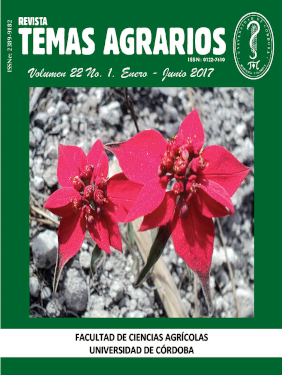Exploitation of waste woody for obtaining ion exchange resins
Aprovechamiento de residuos maderosos para la obtencion de resinas de intercambio iónico

This work is licensed under a Creative Commons Attribution-NonCommercial 4.0 International License.
Show authors biography
Lignocellulosic materials are an important raw material for the preparation of useful products in agriculture, such as biofuels, organic fertilizer, energy and bio-products in general. Among these materials are sawdust and barks from activities related to the primary processing of wood. This research proposes a process for the use of agroindustrial residues of wood to obtain ion exchange resins from forest wood residues to measure the absorption capacity of Pb2+. The residues were modified by chemical treatment with CS2 and NaOH, using a 0.035 residue/NaOH w/w ratio and 1.125 CS2 /residue w/w. pH tests were performed to study the influence on the ion exchange phenomenon, adsorption isotherms were also performed to evaluate the adsorption capacity of the untreated residue and the sulfonated residue. The sulfur groups of the sulfonated wood residue were identified by infrared spectroscopy (FTIR). The results showed that the best lead removal was obtained using a pH of 5 for both materials (89% and 98%) of adsorption in solutions of 100 mg L-1 of Pb2+ and 50 mg/10 mL of adsorbent, respectively. The maximum adsorption capacity of the wood residue was 65 mg g-1 of Pb2+ for the untreated residue, while for the sulfonated residue it was 72 mg g-1 of Pb2+. pH is a limiting factor for evaluating the adsorption capacity of the resin. The wood residues are useful as feedstock to obtain ion exchange resins.
Article visits 1164 | PDF visits
Downloads
- Campbell, J., Lobell, D., Genova, R. and Field, C. 2008. The global potential of bioenergy on abandoned agriculture lands. Environ. Sci. Technol. 42(15): 5791- 5794.
- Colpas, F., Tarón, A. y Fong, W. 2015. Análisis del desarrollo textural de carbones activados preparados a partir de zuro de maíz. Temas Agrarios. 20:(1): 103 – 112.
- Fernandez, R. and Colpas, F. 2015. Mercury and cadmium adsorption in subbituminous xanthated, sulfonated or activated carbon and commercial synthetic resin. Rev. U.D.C.A Act. & Div. Cient. 18(1): 241-250.
- Filiz, N. and Zeynep, E. 2006. Removal of Cu (II) ions by activated poplar sawdust (Samsun Clone) from aqueous solutions, Journal of Hazardous Materials. 137(2):909-914.
- Ghodbane, I. and Oualid, H. 2008. Removing mercury (II) from aqueous media using eucalyptus bark: Kinetic and equilibrium studies, Journal of Hazardous Materials. 160(2):301-309.
- Gómez, L., Colpas, F y Fernández, R. 2014. Cation exchange for mercury and cadmium of xanthated, sulfonated, activated and non-treated subbituminous coal, commercial activated carbon and commercial synthetic resin: effect of preoxidation on xanthation of subbituminous coal. Int J Coal Sci Technol. 1(2):235–240.
- Jiang, Y., Pang, H. and Liao, B. 2009. Removal of copper (II) ions from aqueous solution by modified bagasse, Journal of Hazardous Materials. 164(1):1–9.
- Kumar, A., Rao, N. and Kaul, S. 2000. Alkalitreated straw and insoluble straw xanthate as low cost adsorbents for heavy metal removal - preparation, characterization and application, Bioresource Tecnology. 71(2):133-142.
- Chen, J. y Wang, X. 2000. Removing copper, zinc and lead ions by granular activated carbon in pretreated fixed-bed columns, Sep. Purif. Technol. 19: 157–167.
- Li, Y., Du, Q., Wang, X., Zhang, P., Wang, D., Wang, Z., and Xia, Y. 2010. Removal of lead from aqueous solution by activated carbon prepared from Enteromorpha prolifera by zinc chloride activation. Journal of Hazardous Materials, 183(1), 583-589.
- Liang, S., Guo, X. and Tian, Q. 2011. Adsorption of Pb2+ and Zn2+ from aqueous solutions by sulfured orange peel. Desalination. 275(1):212-216.
- Liang, S., Guo, X., Feng, N. and Tian, Q. 2009. Application of orange peel xanthate for the adsorption of Pb2+ from aqueous solutions. Journal of Hazardous Materials. 170(1):425-429.
- Lohani, M., Singh, A. and Rupainwar, D. 2008. Dhar, Studies on efficiency of guava (Psidium guajava) bark as bioadsorbentfor removal of Hg (II) from aqueous solutions, Journal of Hazardous Materials. 159(2): 626–629.
- Memon, S., Memon, N., Shah, S., Khuhawar, M. and Bhanger, M. 2007. A green and economical sorbent for the removal of cadmium (II) ions, Journal of Hazardous Materials. 139(1):16-121.
- Panda, G., Das, S. and Guha, A. 2008. Biosorption of cadmium and nickel by functionalized husk of Lathyrus sativus. Colloids and Surfaces B: Biointerfaces, 62(2), 173-179.
- Š iban, M., Klasnja, M. and Škrbi , B. 2006. Modified softwood sawdust as adsorbent of heavy metal ions from water, Journal of Hazardous Materials. 136(2):266-271.
- Silgado, K., Marrugo, G. and Puello, J. 2014. Adsorption of Chromium (VI) by Activated Carbon Produced from Oil Palm Endocarp, Chemical Engineering Transactions. 37: 721-726.
- Somerville, C., Youngs, H., Taylor, C., Davis, S. and Long, S. 2010. Feedstocks for lignocellulosic biofuels. Science. 329 (5993): 790-792.
- Taty-Costodes, H., Fauduet, C. and Delacroix, A. 2003. Removal of Cd (II) and Pb (II) ions starting from aqueous solutions by adsorption on sawdust, Journal of Hazardous Materials. 105(1):121-142.
- Torres, M., Roa, G., Barrera, C., Ureña, F. and Pavón, T. 2013. Improving lead sorption through chemical modification of de-oiled allspice husk by xanthate. Fuel.110: 4-11.
- Wan, N. and Hanafiah, M. 2008. Removal of heavy metal ions from wastewater by chemically modified plant wastes as adsorbents: A review, Bioresource Technology. 99(10): 3935-3948.




















